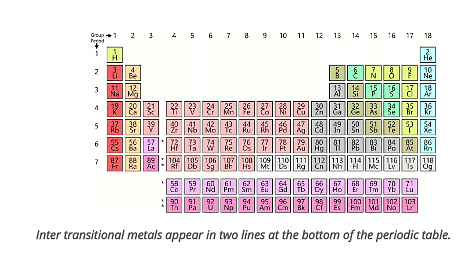Question:
The ′f′ orbitals are half and completely filled, respectively in lanthanide ions
[Given: Atomic no. Eu, 63; Sm, 62; Tm, 69; Tb, 65; Yb, 70; Dy, 66]
The ′f′ orbitals are half and completely filled, respectively in lanthanide ions
[Given: Atomic no. Eu, 63; Sm, 62; Tm, 69; Tb, 65; Yb, 70; Dy, 66]
[Given: Atomic no. Eu, 63; Sm, 62; Tm, 69; Tb, 65; Yb, 70; Dy, 66]
Updated On: Sep 24, 2024
- \(Eu^{2+}\) and \(Tm^{2+}\)
- \(Sm^{2+}\) and \(Tm^{3+}\)
- \(Tb^{4+}\) and \(Yb^{2+}\)
- \(Dy^{3+}\) and \(Yb^{3+}\)
Hide Solution
Verified By Collegedunia
The Correct Option is C
Solution and Explanation
| +2 | +3 | +4 | |
|---|---|---|---|
| Eu | \(4f^7\) | \(4f^6\) | |
| Tm | \(4f^{13}\) | \(4f^{12}\) | |
| Sm | \(4f^6\) | \(4f^5\) | |
| Tb | \(4f^9\) | \(4f^8\) | \(4f^7\) |
| Yb | \(4f^{14}\) | \(4f^{13}\) | |
| Dy | \(4f^{10}\) | \(4f^9\) |
Hence, the pair \(Tb^{+4} Yb^{+2}\) have half filled and completely filled \(f\) subshells respectively.
Was this answer helpful?
1
0
Top Questions on The Lanthanoids
- Which trend is correct regarding ionic radius in the 4f-series (lanthanides)?
- MHT CET - 2025
- Chemistry
- The Lanthanoids
- The first and second ionization enthalpies of lanthanoids are comparable with the element
- KEAM - 2025
- Chemistry
- The Lanthanoids
- What is the formula of lanthanoids with sulfur?
- KEAM - 2025
- Chemistry
- The Lanthanoids
- Number of colourless lanthanoid ions among the following is ____.
\[ \text{Eu}^{3+}, \, \text{Lu}^{3+}, \, \text{Nd}^{3+}, \, \text{La}^{3+}, \, \text{Sm}^{3+} \]- JEE Main - 2024
- Chemistry
- The Lanthanoids
- The Lanthanoid ion which would form coloured compounds is ------------.
Atomic numbers: Yb = 70, Lu = 71, Pr = 59, La = 57- COMEDK UGET - 2024
- Chemistry
- The Lanthanoids
View More Questions
Questions Asked in JEE Main exam
- The value of \( (\sin 70^\circ)(\cot 10^\circ \cot 70^\circ - 1) \) is:
- JEE Main - 2025
- Trigonometric Identities
- Let \( \alpha_1 \) and \( \beta_1 \) be the distinct roots of \( 2x^2 + (\cos\theta)x - 1 = 0, \ \theta \in (0, 2\pi) \). If \( m \) and \( M \) are the minimum and the maximum values of \( \alpha_1 + \beta_1 \), then \( 16(M + m) \) equals:
- JEE Main - 2025
- Binomial Expansion
- A particle moves on a circular path of radius 1 m. Find its displacement when it moves from \( A \rightarrow B \rightarrow A \). Also, its distance are it moves from \( A \rightarrow B \rightarrow A \).
- JEE Main - 2025
- Projectile motion
- A transparent film of refractive index 2.0 is coated on a glass slab of refractive index 1.45. What is the minimum thickness of transparent film to be coated for the maximum transmission of green light of wavelength 550 nm?
- Match the Compounds (List- I) with the appropriate Catalyst/Reagents (List- II) for their reduction into corresponding amines.

- JEE Main - 2025
- Organic Chemistry
View More Questions
Concepts Used:
Lanthanoids

Lanthanoids are at the top of these two-row, while actinoids are at the bottom row.
Properties of Lanthanoids
Lanthanoids are inclusive of 14 elements, with atomic numbers 58-71:
- Cerium - Xe 4f1 5d1 6s2
- Praseodymium - Xe 4f3 6s2
- Neodymium - Xe 4f4 6s2
- Promethium - Xe 4f5 6s2
- Samarium - Xe 4f6 6s2
- Europium - Xe 4f7 6s2
- Gadolinium - Xe 4f7 5d1 6s2
- Terbium - Xe 4f9 6s2
- Dysprosium - Xe 4f10 6s2
- Holmium - Xe 4f11 6s2
- Erbium - Xe 4f12 6s2
- Thulium - Xe 4f13 6s2
- Ytterbium - Xe 4f14 6s2
- Lutetium - Xe 4f14 5d1 6s2
These elements are also called rare earth elements. They are found naturally on the earth, and they're all radioactively stable except promethium, which is radioactive. A trend is one of the interesting properties of the lanthanoid elements, called lanthanide contraction.